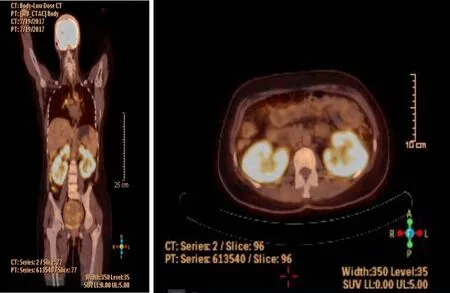Successful treatment of tubulointerstitial nephritis in immunoglobulin G4-related disease with rituximab:A case report
Eray Eroglu, Murat Hayri Sipahioglu, Soner Senel, Sule Ketenci Ertas, Seyma Savas, Figen Ozturk,Ismail Kocyigit, Bulent Tokgoz, Oktay Oymak
Abstract
Key words: Immunoglobulin G4-related disease; Tubulointerstitial nephritis; Rituximab;Case report
INTRODUCTION
Immunoglobulin G4-related disease (IgG4-RD) is a recently recognized systemic fibro-inflammatory condition that mimics several autoimmune, malignant, and rheumatological diseases[1].The hallmarks of the disease are swelling of affected tissue(s)/organ(s) caused by a lymphoplasmacytic infiltrate enriched in IgG4-positive plasma cells, usually accompanied by fibrosis and an increased number of eosinophils[2].Serum IgG4 levels are elevated in about two-thirds of these patients.In addition, a minority of patients have normal serum IgG4 levels despite the presence of the typical IgG4-RD-related histopathological changes[3,4].
IgG4-RD can involve one or multiple organs.Patients often present with subacute development of mass/masses or diffuse enlargement of the affected organ(s).Lymphadenopathy is an important finding, and asthma or allergy is present in approximately 40% of IgG4-RD patients.One of the most common conditions in these patients is autoimmune pancreatitis.This condition often presents as a pancreatic mass or painless obstructive jaundice and, often which can mimics pancreatic cancer.Moreover, patients often present with lacrimal and salivary gland involvement (IgG4-related Mikulicz’s disease), which was once thought to be a subset of Sj?gren’s syndrome (SS).Orbital diseases, including orbital masses and retroperitoneal fibrosis,are other clinical presentations observed in IgG4-RD patients.Depending upon the multiorgan nature of the condition, several clinical phenotypes have recently been identified.These phenotypes include four main groups:(1) Pancreatic hepatobiliary disease; (2) Retroperitoneal fibrosis and/or aortitis; (3) Head-and neck-limited disease; and (4) Classic Mikulicz syndrome with systemic involvement.Renal involvement in patients with IgG4-RD is rarely seen.Only individual case series have been reported in the literature and the most frequent finding in these patients is tubulointerstitial nephritis (TIN)[5-7].
In this case report, we present a case previously misdiagnosed as SS because of the presence of sialadenitis.The patient was referred to our nephrology department because of development of acute kidney dysfunction that had been detected during her last rheumatology visit.Histopathological examination of the kidney biopsy revealed TIN with fibrosis.Serum IgG4 levels were predominantly increased, and the patient was diagnosed with IgG4-RD.Steroid therapy failed to lead to remission;however, complete remission achieved as a result of rituximab administration.
CASE PRESENTATION
Chief complaints
A 34-year-old female patient was admitted to the rheumatology department in July 2017 with complaints of nausea, joint pain, and swelling in the neck.
History of present illness
Her medical history was notable for asthma, rheumatoid arthritis (RA), SS, and sialadenitis.
History of past illness
She had been undergoing follow-up for RA and SS in the rheumatology department since 2015.Her last follow-up was in November 2016, and laboratory results revealed a rheumatoid factor of 273 IU/mL [reference range (RR) 0-20], anti-cyclic citrullinated peptide (anti-CCP) of < 1.5 U/mL (RR 1.5-1.93), creatinine of 0.74 mg/dL (RR 0.5-0.9 mg/dL), erythrocyte sedimentation rate (ESR) of 109 mm/h (RR 0-20), and C-reactive protein (CRP) of 55.6 mg/L (RR 0–6).
Physical examination upon admission
Upon initial physical examination, a 2-3 cm palpable cervical lymphadenomegaly was detected.She had clear lungs and normal heart sounds with no murmurs or gallops upon auscultation.Her current medication upon admission included methotrexate (15 mg once weekly injection), methylprednisolone (16 mg once daily), calcium carbonate(2500 mg) plus cholecalciferol/vitamin D3 (880 IU once daily).
Laboratory examinations
Laboratory results revealed several abnormal findings:Hemoglobin:10.8 g/dL (RR 14-18 g/dL); blood urea nitrogen 33 mg/dL (RR 8-23 mg/dL); creatinine 4.4 mg/dL(RR 0.5-0.9 mg/dl); K:5.6 mmol/L (3.5-5.1 mmol/L); phosphorus 4.6 mmol/L (RR 2.5-4.5 mmol/L); uric acid:8.4 mg/dL (RR 2.4-5.7 mg/dL); ferritin:221.8 ng/mL (RR 15-150 ng/mL); ESR:84 mm/h (RR 0-20); and CRP:23 mg/L (RR 0-6 mg/L).All laboratory results are depicted in Table 1.The patient was referred to the nephrology department.A urine stick test revealed one positive protein.Urine microscopy was negative for casts.The 24-h urine protein level was 0.8 g.Anti-nuclear antibody, antidouble-stranded DNA (dsDNA), anti-glomerular basement membrane, and antineutrophil cytoplasmic antibodies profiles were all negative.The C3 level was 60 mg/dL (RR 90-180 mg/dL), and the C4 level was 15.3 (RR 10-40).
Hypereosinophilia was detected on a peripheral blood smear (eosinophil count was 3.99 × 103/L; RR is 0-0.2 × 103/L), eosinophil percentage was 37.3% (RR 0.9%-2.9%),and the IgG4 level was 2602 mg/dL (RR 3-201 mg/dL).
Imaging examinations
Renal ultrasonography indicated enlarged bilateral kidneys.The right and left kidneys had long axes of 159 and 181 mm, respectively.Bilateral renal echoes were significantly decreased, and hypoechoic areas were observed in both kidneys.Among the enlarged area, the largest one was 54 mm × 42 mm in the lower middle section of the left kidney.
Computed tomography (CT) revealed nodular lesions in the liver, a pancreatic mass, cervical and mediastinal lymph nodes of 2 to 3 cm in diameter.
Positron emission tomography/CT (PET-CT) screening was used based on suspicion of metastatic malignancy or lymphoma.It has been revealed that cervical and mediastinal lymph nodes had high metabolic activity.Infiltrative soft tissue masses were observed ranging from 2 to 4 cm in size in both kidneys.These masses have showed intense hypermetabolic activity in the cortical areas of the kidney parenchyma (standardized uptake value max:8.01) (Figure 1).
Pathological examinations
A kidney biopsy was performed.The biopsy showed intense, connective tissue infiltration between the glomerular and tubular structures.Lymphoplasmacytic and eosinophilic cell infiltrations were observed.IgG4-stained cells were detected on the biopsy specimen (Figure 2).

Table 1 Laboratory parameters of the patient on the admission in July 2017
FINAL DIAGNOSIS
The patient was diagnosed with TIN and IgG4-RD.
TREATMENT
A two-hundred fifty milligram intravenous (iv) pulse of methylprednisolone treatment was administered for three days.Afterwards 1 mg/kg (64 mg) oral methylprednisolone initiated and continued.After ten weeks with steroid treatment,her creatinine level was 3.5 mg/dL in October 2017.Steroid resistance was considered and steroid dose was tapered gradually.She had been treated with mycophenolate mofetil, methotrexate and azathioprine previously in last two years and she had been accepted resistant to these therapies.She refused to receive cyclophosphamide due to her child-bearing potential.Thus, rituximab therapy was considered.The 2 infusions of 1000 mg, 15 d apart.After six months dose was repeated due to partial response in May 2018.Total dose of rituximab reached to 4000 mg.
OUTCOME AND FOLLOW-UP

Figure 1 Positron-emission tomography-computed tomography scan reported as increased fluorodeoxyglucose uptake in infiltrative soft tissue areas in both kidneys (standardized uptake value max:8.01).
Her last visit was in May 2019.After one year of rituximab therapy serum creatinine level decreased from 4.4 mg/dL to 1.6 mg/dL, ESR decreased from 109 mm/h to 13 mm/h (RR 0-20), and CRP decreased from 55.6 mg/L to 5 mg/L (RR 0–6).She has no complaint.All pathologic lymph nodes and masses were also disappeared.Clinical and laboratory remission was achieved.The steroid therapy withdrawal was achieved six months ago.
DISCUSSION
The diagnosis of IgG4-RD is often challenging due to a complex presentation as this condition mimics malignancies and autoimmune rheumatic diseases.Herein, we reported a case of IgG4-RD and TIN that was diagnosed by kidney biopsy.IgG4-RD rarely involves the kidneys, but the finding of kidney involvement has been described in some case series and in individual case reports.The most common renal-related finding is TIN.However, it has been reported that many of the affected IgG4-RD patients with kidney disease are middle-aged and older men, and our particular case involved a middle-aged woman[1,8].Lymphoplasmacytic infiltration of the renal interstitium and presence of fibrosis were distinct features to distinguish IgG4RD-TIN from other TIN cases as has been shown in our case.Immunohistochemistry staining of renal biopsy specimen have revealed increased numbers of IgG4-positive plasma cells supported the diagnosis of IgG4RD-TIN.On the other hand, nodular lesions in kidneys mimicking metastatic malignancy is a very rare condition as in this case[2,9].Kawanoet al[10]recently reported a series of 41 Japanese IgG4-RD patients identified between 2004 and 2011 who presented with histopathological findings consistent with kidney involvement.Twenty-nine patients underwent CT scans, and the most common radiological findings were multiple low-density lesions with subsequent diffuse bilateral renal swelling as the second most common involvement.A solitary hypovascular parenchymal nodule was detected in just one patient in that study.More recently, Bianchiet al.reported an IgG4-RD case that presented with a solid mass in kidney, which mimicked a malignancy[9].Our case also showed both bilateral enlarged kidneys with multiple lesions in both kidneys.This is important because establishing a differential diagnosis between IgG4-RD and malignancy is challenging.It has been well-established that conventional imaging techniques (ultrasound, CT,magnetic resonance imaging, and PET/CT) have limited efficiency in diagnosing IgG4-RD[11].A biopsy from the affected organ remains the cornerstone for the IgG4-RD diagnosis[6].
However, the optimal treatment for IgG4-RD has not yet been well defined yet, an international consensus guideline has recently been published[12].The treatment recommendations consist of several issues:(1) Glucocorticoids are the first-line drugs for remission induction in all patients with active, IgG4-RD, unless contraindications to steroids are present; (2) After successful achievement of induction therapy, certain patients will need maintenance therapy; and (3) Retreatment with glucocorticoids is indicated in some patients in whom relapse following successful remission induction was observed.Otherwise, some experts recommend the initiation of steroid-sparing immunosuppressive agents from treatment start due to the ultimate failure of steroid therapy and potential toxicities associated with long-term steroid treatment.Steroids and cyclophosphamide combinations have recently been reported to cause a low risk of relapse in these patients[13].The risk of infertility could also be a barrier to this treatment combination, especially in women of child-bearing potential as in our case.

Figure 2 Histological section of kidney staining.
It has been shown that B-cell depletion leads to the targeted and quick reduction of serum IgG4 concentrations, with relative preservation of the concentrations of other immunoglobulins and immunoglobulin subclasses.Authors also speculate that rituximab achieves its effects in IgG4-RD by depleting the pool of B lymphocytes that replenish short-lived IgG4-secreting plasma cells[14-16].Thus, rituximab was considered as a promising option for these cases.When we review the literature, the efficacy of Bcell depletion with rituximab in patients with that is resistant to steroids and other therapies has been recently demonstrated.Khosroshahiet al[14,15]have been treated successfully total 14 patients with IgG4-RD in a two different case series in the literature.They showed that almost all patients had clinical and laboratory response to rituximab.Only a few patients (4 of 14) have received second infusion six months after first infusion.More recently a retrospective study has been conducted in France with 156 patients with IgG4-RD and 33 patients have been treated with rituximab.Clinical response was noted in 29/31 (93.5%) symptomatic patients.Maintenance therapy (second dose six months after initial dose before occurrence of a relapse) with rituximab have been associated with longer relapse-free survival (41vs21 mo;P=0.02) comparing to patients whom had been administered single rituximab dose[16].They concluded that rituximab might be a novel treatment option for both induction and maintenance therapy in these patients.However, rituximab has not been evaluated in a randomized trial in patients with IgG4-RD, and its use for this disease might be evaluated for off-label use by drug control agencies.
In this unique case, we showed that rituximab therapy was successful in IgG4-RD and TIN treatment especially resistant to steroid and other therapies.Future randomized trials with larger patients are needed to establish the usage of rituximab in these patients.
 World Journal of Clinical Cases2019年16期
World Journal of Clinical Cases2019年16期
- World Journal of Clinical Cases的其它文章
- Role of infrapatellar fat pad in pathological process of knee osteoarthritis:Future applications in treatment
- Application of Newcastle disease virus in the treatment of colorectal cancer
- Reduced microRNA-451 expression in eutopic endometrium contributes to the pathogenesis of endometriosis
- Application of self-care based on full-course individualized health education in patients with chronic heart failure and its influencing factors
- Predicting surgical site infections using a novel nomogram in patients with hepatocelluar carcinoma undergoing hepatectomy
- Serological investigation of lgG and lgE antibodies against food antigens in patients with inflammatory bowel disease
